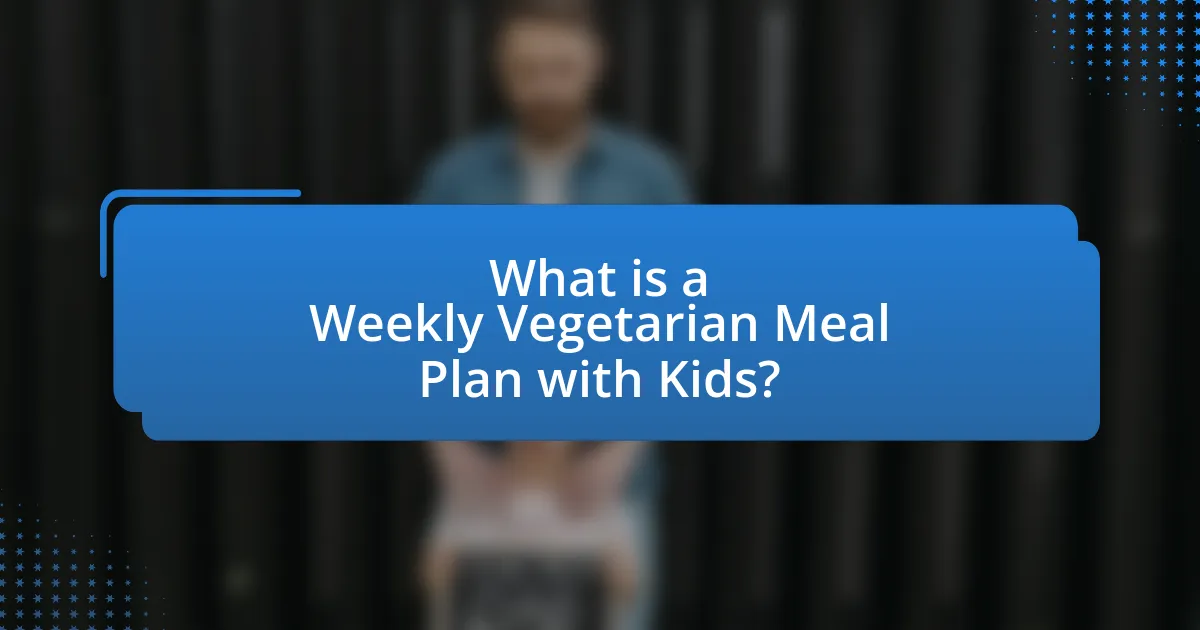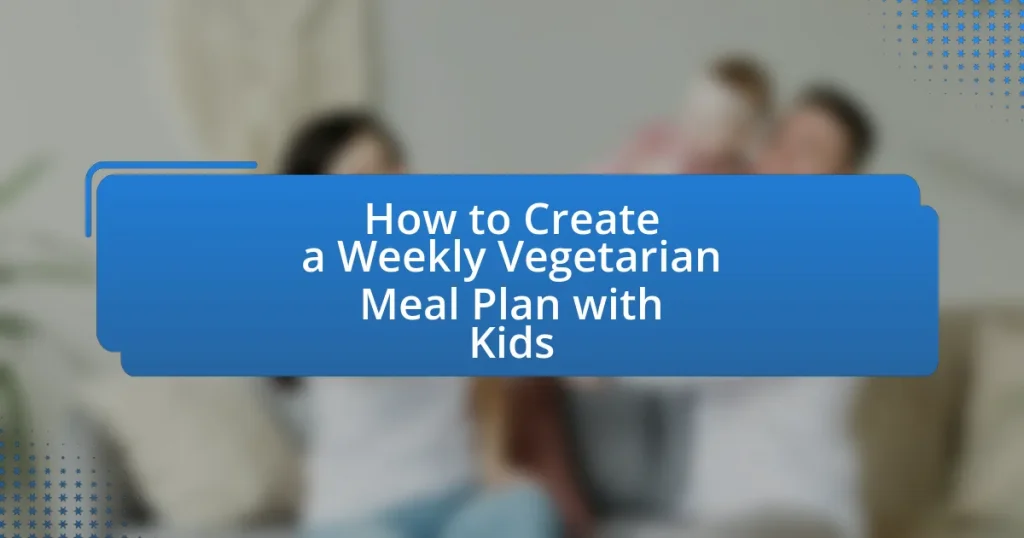Creating a weekly vegetarian meal plan with kids involves a structured approach to ensure balanced nutrition while catering to children’s tastes. The article outlines the benefits of vegetarian diets for children, including improved health outcomes and the development of healthy eating habits. It emphasizes the importance of involving children in meal planning and preparation, which can enhance their willingness to try new foods. Key components of a successful meal plan include variety, balance, and engagement, along with practical strategies for overcoming common challenges such as picky eating and time constraints. The article also provides tips for incorporating seasonal ingredients and celebrating meal planning successes, making it a comprehensive guide for families looking to adopt a vegetarian lifestyle.

What is a Weekly Vegetarian Meal Plan with Kids?
A weekly vegetarian meal plan with kids is a structured outline of meals designed to provide balanced nutrition while catering to children’s tastes and preferences. This plan typically includes a variety of fruits, vegetables, whole grains, legumes, nuts, and dairy or dairy alternatives, ensuring that children receive essential nutrients such as protein, iron, and calcium. For example, a meal plan might feature dishes like vegetable stir-fry with tofu, lentil soup, and whole grain pasta with marinara sauce, which are appealing to children and easy to prepare. Research indicates that involving children in meal planning can increase their willingness to try new foods, making it an effective strategy for promoting healthy eating habits.
How can a vegetarian meal plan benefit families with children?
A vegetarian meal plan can benefit families with children by promoting healthier eating habits and providing essential nutrients. Research indicates that vegetarian diets are often rich in fruits, vegetables, whole grains, and legumes, which contribute to better overall health and lower risks of chronic diseases in children. For instance, a study published in the Journal of the American Dietetic Association found that children who consume plant-based diets tend to have lower body mass indexes and improved cholesterol levels. Additionally, vegetarian meal plans can encourage children to develop a taste for diverse foods, fostering better eating habits that can last a lifetime.
What nutritional advantages does a vegetarian diet offer for kids?
A vegetarian diet offers several nutritional advantages for kids, including higher intake of essential nutrients such as fiber, vitamins, and minerals. This diet is typically rich in fruits, vegetables, whole grains, and legumes, which contribute to improved digestion and lower risks of chronic diseases. Research indicates that children following a vegetarian diet often have lower cholesterol levels and healthier body weights, as plant-based foods are generally lower in saturated fats. Additionally, a study published in the Journal of the American Dietetic Association found that vegetarian children tend to consume more antioxidants, which support immune function and overall health.
How does involving kids in meal planning promote healthy eating habits?
Involving kids in meal planning promotes healthy eating habits by increasing their interest in food choices and encouraging them to try new foods. When children participate in selecting meals, they are more likely to feel a sense of ownership and responsibility, which can lead to better acceptance of nutritious options. Research indicates that children who are engaged in meal preparation are more inclined to consume fruits and vegetables, as they develop a positive attitude towards these foods. A study published in the Journal of Nutrition Education and Behavior found that children who participated in cooking activities were more likely to choose healthier foods and exhibit improved dietary habits.
What are the key components of a successful vegetarian meal plan?
A successful vegetarian meal plan includes a variety of nutrient-dense foods, balanced macronutrients, and adequate meal preparation. Nutrient-dense foods such as fruits, vegetables, whole grains, legumes, nuts, and seeds provide essential vitamins and minerals. Balanced macronutrients ensure that the meal plan includes sufficient protein, healthy fats, and carbohydrates, which are crucial for overall health. Meal preparation, including planning and cooking in advance, helps maintain consistency and reduces the likelihood of unhealthy choices. Research indicates that diverse diets rich in plant-based foods can lead to improved health outcomes, including lower risks of chronic diseases.
What types of vegetarian foods should be included in the meal plan?
A meal plan for vegetarian diets should include a variety of foods such as fruits, vegetables, whole grains, legumes, nuts, and seeds. Fruits and vegetables provide essential vitamins and minerals, while whole grains like quinoa, brown rice, and oats offer fiber and energy. Legumes, including beans, lentils, and chickpeas, are excellent sources of protein and iron. Nuts and seeds contribute healthy fats and additional protein. Research indicates that a diverse vegetarian diet can meet nutritional needs effectively, as outlined in the “Dietary Guidelines for Americans,” which emphasize the importance of including a wide range of food groups for balanced nutrition.
How can parents ensure variety and balance in the meal plan?
Parents can ensure variety and balance in the meal plan by incorporating a diverse range of food groups and rotating ingredients weekly. This approach includes selecting fruits, vegetables, whole grains, protein sources like legumes and nuts, and healthy fats to create balanced meals. Research indicates that a varied diet not only meets nutritional needs but also encourages children to develop a taste for different foods, which can lead to healthier eating habits. For instance, the Dietary Guidelines for Americans recommend including a variety of vegetables from different subgroups, such as dark green, red and orange, legumes, starchy, and other vegetables, to ensure a comprehensive nutrient intake.
How can parents engage their kids in the meal planning process?
Parents can engage their kids in the meal planning process by involving them in decision-making and encouraging creativity. For instance, parents can ask children to choose their favorite vegetables or proteins to include in meals, fostering a sense of ownership. Research indicates that children who participate in meal planning are more likely to try new foods and develop healthier eating habits. A study published in the Journal of Nutrition Education and Behavior found that children who were involved in meal preparation were more likely to consume fruits and vegetables. This active participation not only enhances their culinary skills but also strengthens family bonds through shared activities.
What activities can make meal planning fun for children?
Engaging children in meal planning can be made fun through activities such as creating a colorful food chart, where they can visually select their favorite fruits and vegetables, and participating in a cooking competition, allowing them to prepare simple dishes. These activities not only stimulate creativity but also encourage children to take ownership of their food choices. Research indicates that children who are involved in meal planning are more likely to try new foods and develop healthier eating habits, as highlighted in a study published in the Journal of Nutrition Education and Behavior.
How can parents incorporate kids’ preferences into the meal plan?
Parents can incorporate kids’ preferences into the meal plan by actively involving them in the meal planning process. Engaging children in discussions about their favorite foods and allowing them to choose meals or ingredients fosters a sense of ownership and increases their willingness to try new vegetarian options. Research indicates that children are more likely to eat meals they helped plan, as it enhances their interest and investment in the food (Contento, 2011, “Nutrition Education: A Key to Food and Nutrition Security”). By integrating their preferences, parents can create a balanced vegetarian meal plan that satisfies both nutritional needs and children’s tastes.

What steps are involved in creating a Weekly Vegetarian Meal Plan with Kids?
Creating a Weekly Vegetarian Meal Plan with Kids involves several key steps. First, involve the kids in meal planning by discussing their preferences and dietary needs, which fosters engagement and ensures they are more likely to enjoy the meals. Next, select a variety of vegetarian recipes that include fruits, vegetables, whole grains, and plant-based proteins to ensure nutritional balance. After that, create a shopping list based on the chosen recipes, ensuring to include all necessary ingredients. Then, schedule a cooking day where kids can help prepare meals, teaching them cooking skills and the importance of healthy eating. Finally, store meals in appropriate portions for easy access throughout the week, promoting convenience and encouraging kids to choose healthy options. These steps not only create a structured meal plan but also educate children about nutrition and cooking.
How do you start the meal planning process?
To start the meal planning process, first assess dietary preferences and nutritional needs of the family, particularly focusing on vegetarian options. This initial step ensures that the meals planned will be enjoyable and healthy for everyone involved. Research indicates that involving children in meal planning increases their willingness to try new foods and fosters healthier eating habits.
What tools or resources can assist in meal planning?
Meal planning can be effectively assisted by various tools and resources such as meal planning apps, recipe websites, and grocery list generators. Meal planning apps like Mealime and Paprika allow users to create customized meal plans, access a database of recipes, and generate shopping lists based on selected meals. Recipe websites such as AllRecipes and Epicurious provide extensive collections of vegetarian recipes, often with user reviews and nutritional information, which can help in selecting meals that appeal to children. Additionally, grocery list generators streamline the shopping process by organizing ingredients needed for the planned meals, ensuring that all necessary items are purchased. These tools enhance efficiency and organization in meal planning, making it easier to create a weekly vegetarian meal plan that accommodates family preferences.
How can families set goals for their meal plan?
Families can set goals for their meal plan by identifying dietary preferences, nutritional needs, and budget constraints. First, families should discuss and agree on the types of vegetarian meals they enjoy, ensuring that everyone’s tastes are considered. Next, they can establish specific nutritional goals, such as incorporating a variety of vegetables, whole grains, and protein sources, which can be guided by dietary recommendations from health organizations. Finally, families should set a budget for groceries, which helps in planning meals that are both affordable and aligned with their dietary goals. This structured approach ensures that the meal plan is enjoyable, nutritious, and financially feasible.
What strategies can help in organizing the meal plan?
To effectively organize a meal plan, one should implement strategies such as creating a weekly menu, involving children in meal preparation, and utilizing a grocery list. A weekly menu provides structure and ensures a balanced diet by planning meals in advance, which can reduce last-minute decisions that often lead to unhealthy choices. Involving children in meal preparation fosters their interest in healthy eating and teaches them valuable cooking skills. Utilizing a grocery list based on the planned meals helps streamline shopping, minimizes food waste, and ensures that all necessary ingredients are on hand. These strategies collectively enhance the organization of a meal plan, making it easier to maintain a vegetarian diet while accommodating the preferences of children.
How can families create a shopping list based on the meal plan?
Families can create a shopping list based on the meal plan by first reviewing the planned meals for the week and identifying all the ingredients needed. Each meal should be broken down into its components, listing out specific items such as vegetables, grains, proteins, and spices. For instance, if a meal plan includes a vegetable stir-fry, the shopping list should include bell peppers, broccoli, soy sauce, and rice.
Next, families should consolidate the ingredient list by grouping similar items together, which helps in organizing the shopping trip and ensuring nothing is overlooked. This method not only streamlines the shopping process but also minimizes food waste by ensuring that only necessary items are purchased. By following this structured approach, families can efficiently create a comprehensive shopping list that aligns with their vegetarian meal plan.
What tips can help streamline meal preparation and cooking with kids?
To streamline meal preparation and cooking with kids, involve them in the planning process by selecting recipes together. This engagement increases their interest and investment in the meals. Organizing ingredients and tools before starting helps maintain focus and efficiency, reducing chaos during cooking. Additionally, assigning age-appropriate tasks, such as washing vegetables or stirring, fosters independence and teaches valuable skills. Research indicates that children who participate in cooking are more likely to try new foods and develop healthier eating habits.
How can families adapt the meal plan throughout the week?
Families can adapt the meal plan throughout the week by incorporating flexible ingredients and varying cooking methods. For instance, they can use a base of grains like quinoa or rice and add different vegetables and proteins each day to create diverse meals. This approach allows families to utilize leftovers creatively, reducing food waste while maintaining variety. Research indicates that meal flexibility can enhance family engagement in cooking, making it more enjoyable for children and encouraging healthier eating habits.
What should families do if they encounter food waste or leftovers?
Families should prioritize reducing food waste by properly storing leftovers and creatively repurposing them into new meals. For instance, leftover vegetables can be transformed into soups or stir-fries, while excess grains can be used in salads or casseroles. According to the USDA, approximately 30-40% of the food supply in the United States is wasted, highlighting the importance of effective management of leftovers to minimize waste and maximize resources.
How can parents modify the meal plan based on seasonal ingredients?
Parents can modify the meal plan based on seasonal ingredients by incorporating fruits and vegetables that are currently in season, which enhances flavor and nutritional value. For example, during summer, parents can include tomatoes, zucchini, and berries, while in winter, they can opt for root vegetables like carrots and potatoes, as well as citrus fruits. Seasonal ingredients are often fresher and more affordable, as they are harvested at their peak, leading to better taste and higher nutrient content. Research indicates that consuming seasonal produce can increase dietary diversity and improve overall health, making it a beneficial practice for families.

What are some common challenges in creating a Weekly Vegetarian Meal Plan with Kids?
Creating a Weekly Vegetarian Meal Plan with Kids often faces challenges such as picky eating habits, limited ingredient preferences, and time constraints for meal preparation. Picky eating can lead to resistance against trying new vegetarian foods, making it difficult to introduce a variety of vegetables and legumes. Limited ingredient preferences may restrict meal options, as children might favor familiar foods over diverse vegetarian choices. Additionally, time constraints can hinder the planning and preparation of meals, especially for busy families, making it challenging to maintain a consistent meal plan. These factors collectively complicate the process of developing a balanced and appealing vegetarian meal plan for children.
What obstacles might families face during meal planning?
Families may face several obstacles during meal planning, including time constraints, dietary preferences, and budget limitations. Time constraints often arise from busy schedules, making it difficult to dedicate sufficient time for planning and preparation. Dietary preferences can complicate meal planning, especially when family members have different tastes or restrictions, such as vegetarianism or food allergies. Budget limitations also pose a challenge, as families must balance healthy eating with financial considerations, often leading to compromises in meal quality or variety. These factors collectively hinder effective meal planning and can result in stress and dissatisfaction with family meals.
How can parents address kids’ reluctance to try new foods?
Parents can address kids’ reluctance to try new foods by involving them in the meal preparation process. Research indicates that children who participate in cooking are more likely to try and enjoy new foods, as they develop a sense of ownership and curiosity about the meals they help create. For instance, a study published in the Journal of Nutrition Education and Behavior found that children who engaged in cooking activities were more open to tasting unfamiliar foods. Additionally, parents can introduce new foods alongside familiar favorites, making the experience less intimidating and more appealing.
What strategies can help manage time constraints during meal prep?
To manage time constraints during meal prep, batch cooking is an effective strategy. This involves preparing large quantities of food at once, which can significantly reduce the time spent cooking throughout the week. Research indicates that individuals who engage in batch cooking can save up to 10 hours a week compared to daily cooking routines. Additionally, organizing ingredients and utilizing time-saving kitchen tools, such as food processors and slow cookers, can streamline the meal prep process. These methods not only enhance efficiency but also ensure that meals are ready to serve quickly, making it easier to maintain a vegetarian meal plan for families.
How can families overcome these challenges effectively?
Families can effectively overcome challenges in creating a weekly vegetarian meal plan by involving children in the planning and cooking process. Engaging kids fosters a sense of ownership and interest in the meals, making them more likely to try new foods. Research indicates that children who participate in meal preparation are more open to eating a variety of foods, including vegetables. Additionally, setting a consistent schedule for meal planning and preparation helps families stay organized and reduces stress. Studies show that families who plan meals together report higher satisfaction and less food waste, reinforcing the benefits of collaboration in the kitchen.
What resources are available for meal planning support?
Meal planning support resources include meal planning apps, websites, cookbooks, and community programs. Apps like Mealime and Yummly offer customizable meal plans and grocery lists tailored to dietary preferences, including vegetarian options. Websites such as EatingWell and Allrecipes provide extensive recipe databases and meal planning tools. Cookbooks focused on vegetarian meals, like “Plenty” by Yotam Ottolenghi, offer structured meal ideas and recipes. Additionally, community programs, such as local cooking classes or nutrition workshops, can provide hands-on support and guidance for families looking to create vegetarian meal plans.
How can families celebrate successes in their meal planning journey?
Families can celebrate successes in their meal planning journey by organizing a special meal or family gathering to acknowledge their achievements. This celebration can include cooking a favorite vegetarian dish that the family successfully planned and prepared together, reinforcing teamwork and collaboration. Research indicates that shared meals enhance family bonding and communication, making this a meaningful way to recognize progress. Additionally, families can create a visual chart to track their meal planning milestones, rewarding themselves with small treats or outings when they reach specific goals, further motivating them to continue their healthy eating habits.
What are some practical tips for creating a successful vegetarian meal plan with kids?
To create a successful vegetarian meal plan with kids, involve them in the planning and preparation process. Engaging children in selecting recipes and shopping for ingredients increases their interest in the meals. Incorporate a variety of colorful fruits and vegetables to make meals visually appealing, as studies show that children are more likely to eat foods that look attractive. Additionally, include kid-friendly recipes that allow for customization, such as build-your-own veggie tacos or pizza, which encourages them to try new ingredients. Lastly, establish a routine by planning meals for the week, which can help children anticipate and look forward to mealtime, fostering a positive eating environment.
How can families incorporate fun themes or challenges into their meal planning?
Families can incorporate fun themes or challenges into their meal planning by designating specific days for themed meals, such as “Taco Tuesday” or “Meatless Monday.” This approach not only adds excitement but also encourages children to participate in meal preparation and learn about different cuisines. For instance, a “World Cuisine Week” can introduce dishes from various countries, fostering cultural awareness and culinary skills. Engaging children in these themes can enhance their interest in food and nutrition, making meal times more enjoyable and educational.
What are the best practices for maintaining consistency in meal planning?
The best practices for maintaining consistency in meal planning include establishing a regular schedule, creating a diverse menu, and involving children in the planning process. A regular schedule, such as planning meals every Sunday, helps set a routine that can be easily followed. Creating a diverse menu ensures that meals remain interesting and appealing, which can prevent boredom and encourage healthy eating habits. Involving children in the planning process fosters their interest in food and nutrition, making them more likely to try new dishes and stick to the meal plan. Research indicates that family involvement in meal preparation can lead to healthier eating patterns among children (Harrison et al., 2015, Journal of Nutrition Education and Behavior).


